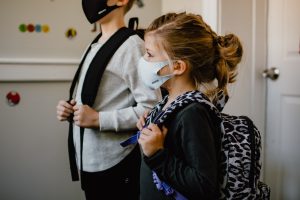
As the Covid-19 pandemic continues many states currently require individuals to wear masks in public settings to minimize the spread of the Covid-19 virus. Masks are also recommended by Center for Disease Control and Prevention (CDC) to anyone 2 years of age and older. According to information on the CDC website, masks prevent respiratory droplets from traveling into the air which is likely to occur when people cough, sneeze, or talk. Therefore, if a person who is ill is in a public setting, the use of a mask will decrease the likelihood of them spreading the virus to other people. However, many children, especially children with autism, may resist wearing mask. I am including below some tips and resources for helping children wear marks.
- Explain, in language that is appropriate for the child, why people need to wear masks. One way to do this is to present a social story to your child. Below are links to a couple of social stories on this topic:
https://www.autismlittlelearners.com/2020/04/seeing-people-wearing-masks-story.html
https://www.youtube.com/watch?v=lnP-uMn6q_U
- Consider your child’s likes and dislikes and choose a mask that is more likely to be tolerated by your child. Masks are now available in different sizes, colors, different material (e.g., cotton vs synthetic), differing characters, with over-the-ear elastic or with the option to tie on the back to the head, and so on. Consider purchasing a few different types of masks or allowing your child to choose a couple.
- Start slowly! When first introducing the mask to your child be sure to watch your child’s reaction. Does your child attempt to place the mask on their face? Does your child push the mask away? You want to begin with what your child already accepts and then slowly increase the requirement. So, if your child currently wears the mask for 2 seconds and then takes it off, you want to briefly (2 or less second) place the mask on your child, provide your child with access to a preferred item (praise, a toy), and then remove the mask. You then provide your child with a break, allowing your child to return to their regular routine, and then you re-present the mask. It is likely helpful if you write down a list of potential steps (e.g., duration of wearing masks) you will follow. A sample desensitization log is available on the website of the Autism and Intellectual Disabilities in Pennsylvania.
- Provide your child with multiple opportunities to practice. Given that you will need to slowly increase the amount of time your child is wearing the mask, you want to program multiple opportunities across the day for your child to wear the mask for brief periods.
- Pair the mask with preferred activities and reinforcers. You should consider which activities your child enjoys doing and ask your child to wear the mask while completing these activities. For instance, if your child enjoys watching TV, one option would be to have your child wear the mask while watching TV. This will be helpful because the mask may become a preferred item due to its association with another preferred activity but also because you child will be distracted by the preferred activity and thus will be less likely to resist wearing the mask.
For additional resources on helping a child with autism tolerate masks check out these resources:
https://paautism.org/resource/desensitization-mask-communication/
https://www.alpinelearninggroup.org/media-center/video-library.php
